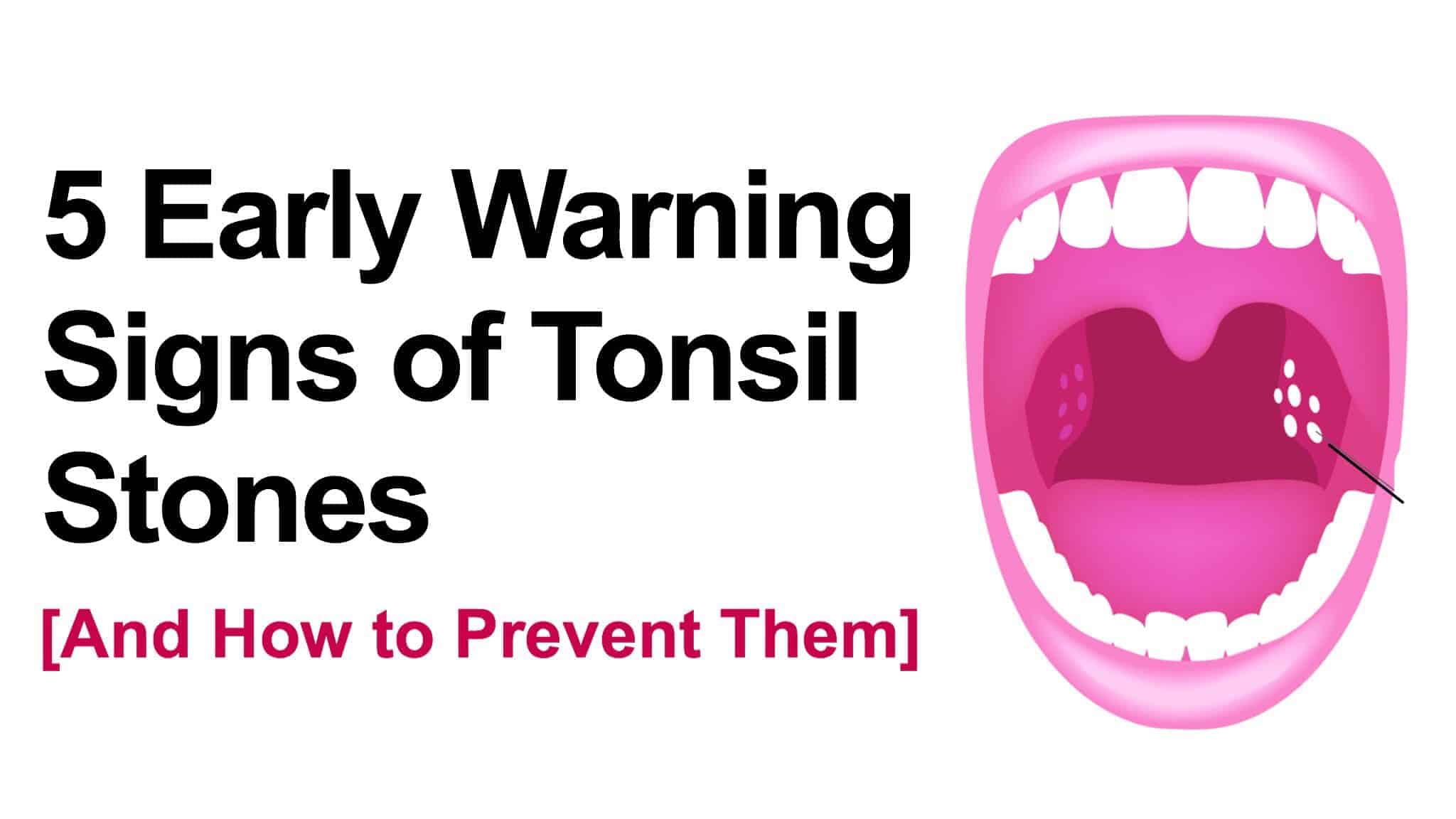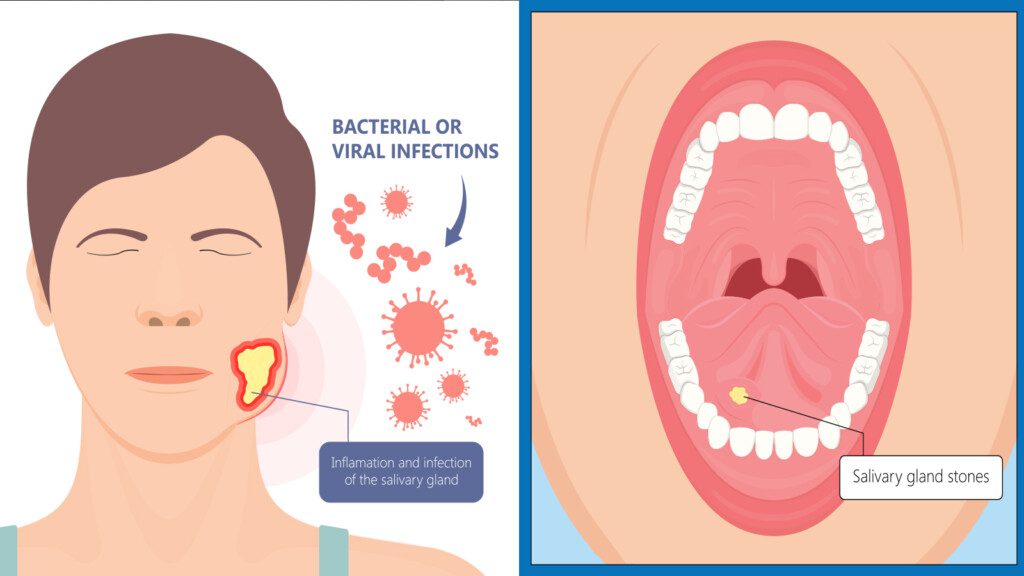Until you have one, you might not even know what tonsil stones are.
So… what are they?
Tonsil stones are hardened yellow or white bumps that appear on or within the tonsils. Small as a grain of rice, many people who acquire tonsil stones remain unaware of their presence.
After some time, the stones – which consist of food debris, dead cells, mucus, and saliva – can cause health complications. Bacteria and fungi also feed on tonsil stones, creating a distinct, unpleasant odor.
Why do tonsil stones appear? We’re all born with two tonsils, which reside in a kidney-bean-shaped crevice on both sides of the tongue near the pharynx. This area that constitutes our tonsils is full of nooks and crannies, allowing debris to settle. Over time, the debris may harden (or calcify) into stones.
What Are the Tonsil Stones?
The ‘tonsillolith’ produces five main (sometimes early) symptoms, provided the tonsil stone is large enough. Here are the symptoms you should know:
1. Bad breath
Also known as halitosis, progressively lousy breath often accompanies a tonsil stone. In one study of patients, researchers discovered that 75 percent of tonsil stones contain unstable sulfur compounds. Sulfur produces a notoriously bad smell, which is thought to be the catalyst for the terrible breath that accompanies the stones. This sulfur is produced by the anaerobic bacteria that feed on the stone’s debris.
2. Whitish or Yellowish Debris
While some tonsil stones are visible in the back of the throat, some are hidden. Stones that are just visible are often surrounded by a solid, plaque-like white substance (similar to the substance that appears on the tongue.) Additionally, the stone may appear as tiny rocks that stay trapped in your mouth.
3. Secondary oral health conditions
People who do not regularly brush or floss their teeth are more vulnerable to tonsil stones. Poor oral health may also contribute to a second condition, namely gum disease, oral infections, or tooth decay. Furthermore, untreated tonsil stones may produce plaque-like patches at the back of the throat.
4. Trouble swallowing
Swollen tonsils and tonsil stones can make it more difficult to swallow. Whether or not this symptom arises depends on the size and location of it. Difficulty swallowing is symptomatic of numerous medical conditions, so an exam may be necessary to determine the root cause.
5. Ear pain
Tonsil stones can grow any place in or around the tonsil. Due to shared nerve pathways, they may cause a person to feel pain in the ear, even though the stone itself is not touching the ear.
How to Get Rid of Tonsil Stones
There are several effective methods available for removing tonsil stones. While the success of these techniques may vary depending on individual cases, they can be beneficial in dislodging these troublesome formations. Let’s delve into some additional approaches:
- Nasal irrigation: They can sometimes be dislodged by performing nasal irrigation. This involves using a saline solution to flush out the nasal passages, which can help remove any trapped debris, including tonsil stones. This method targets the nasal cavity and can reach the tonsils, providing a thorough cleanse.
- Oral irrigators: Oral irrigators, such as water flossers, are commonly used for dental hygiene. But they can also be employed to tackle tonsil stones. By directing a stream of water at the back of the throat, these devices can dislodge and flush out the stones, effectively minimizing their presence.
- Non-alcoholic mouthwash: Rinsing your mouth with a non-alcoholic mouthwash can help alleviate the discomfort associated with this condition and contribute to their removal. The mouthwash’s antiseptic properties can assist in loosening the stones, making it easier to dislodge them.
- Saltwater gargling with added pressure: While gargling with salt water can help alleviate throat discomfort caused by this condition, applying additional pressure during gargling can enhance the dislodging process. Vigorously swishing the saltwater solution around your mouth and directing it toward the back of your throat increases the likelihood of dislodging the stones.
- Professional removal: In cases where self-removal methods prove ineffective or if you experience severe complications, seeking professional assistance is advisable. An otolaryngologist, or ENT specialist, can evaluate your condition and perform procedures such as laser treatment or surgical removal of the tonsils (tonsillectomy). Tonsil stones are most common in those who acquire chronic tonsillitis. The surgical removal of the tonsils (a tonsillectomy) eliminates the possibility of stones developing for this demographic. However, various research studies showing the high complication rate of the procedure (around 20 percent) and the severe conditions (e.g., deep infection of the tonsil or tonsil abscess) are giving some a second pause.
How to Prevent Tonsil Stones
Preventing tonsil stones is crucial for those who want to avoid the discomfort and inconvenience they can bring. In addition to the aforementioned techniques, there are a few more preventive measures you can incorporate into your daily routine:
- Practice good oral hygiene: Alongside regular brushing and flossing, paying attention to the back of your tongue can significantly reduce the formation of tonsil stones. Bacteria will often accumulate on the tongue’s surface, providing a breeding ground for the debris contributing to these stones’ formation. Use a tongue scraper or your toothbrush to gently clean the back of your tongue during your oral hygiene routine.
- Quit smoking: Smoking damages overall health and increases the risk of developing this condition. The chemicals and toxins in cigarettes can irritate and inflame the tonsils, promoting the accumulation of debris and the formation of stones. By quitting smoking, you can significantly reduce the likelihood of developing tonsil stones and improve your overall well-being.
- Stay hydrated: Drinking adequate water throughout the day is essential for maintaining optimal oral health. Proper hydration helps prevent the buildup of bacteria and debris in the mouth, reducing the chances of this formation. Aim to drink at least eight glasses of water daily, and consider using a humidifier in dry environments to prevent excessive drying of the throat and mouth.
Final Thoughts on Understanding How to Deal With Tonsil Stones
In conclusion, dealing with this condition can be uncomfortable and frustrating. However, you can effectively manage and prevent their formation with the right knowledge and techniques. From gentle home remedies to seeking professional assistance when necessary, various options are available to help you remove tonsil stones and alleviate any associated symptoms.
Remember to exercise caution when dislodging tonsil stones, as improper techniques may lead to complications. If self-removal methods prove ineffective or if you experience persistent issues, it’s always wise to consult a healthcare professional for proper evaluation and guidance.
By practicing good oral hygiene, staying hydrated, and making healthy lifestyle choices such as quitting smoking, you can reduce the likelihood of stone formation and maintain better oral health. Stay proactive in your oral care routine, and don’t hesitate to seek help. With these preventive measures and the right approach, you can effectively manage tonsil stones and enjoy a healthier, more comfortable life.















 Community
Community

